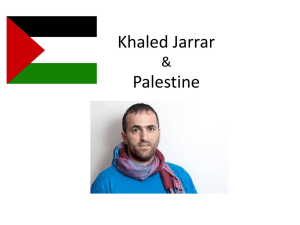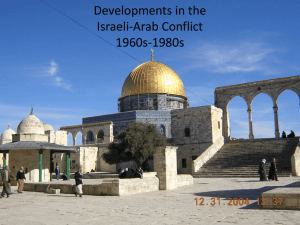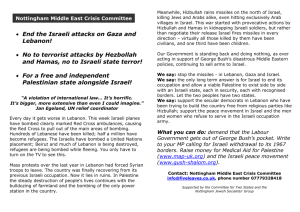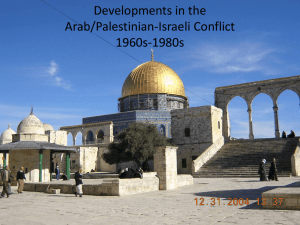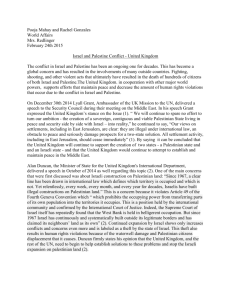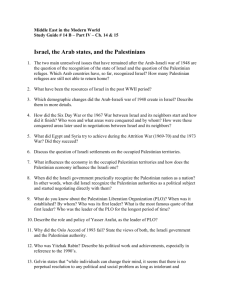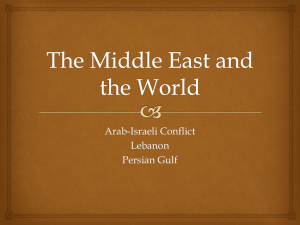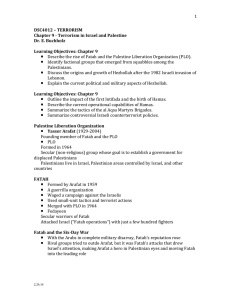Sociology in Our Times: The Essentials
advertisement
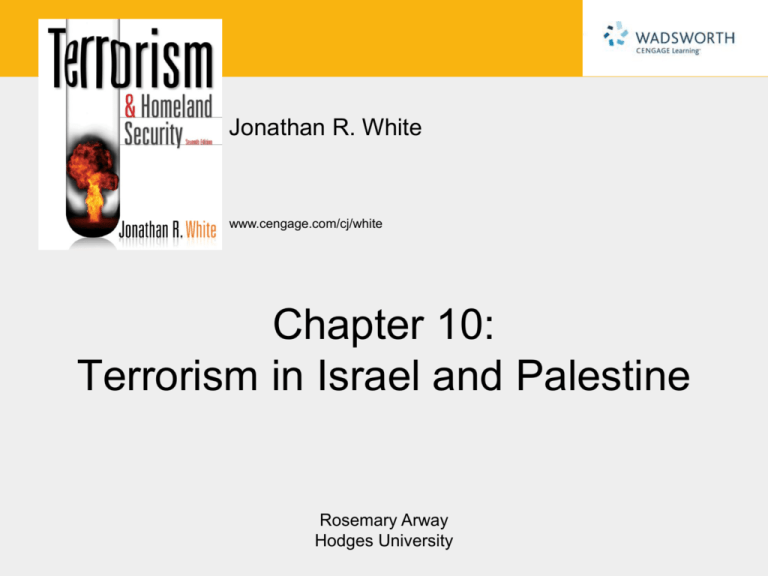
Jonathan R. White www.cengage.com/cj/white Chapter 10: Terrorism in Israel and Palestine Rosemary Arway Hodges University Palestine Liberation Organization PLO – Palestinian Liberation Organization: o Secular organization o Yasser Arafet – its leader and founder (1964) o Attempted to establish a government for displaced Palestinians o Purpose was to create a political organization to help form a multinational alliance against Israel o Looked to Arab governments to jointly launch a war against Israel Palestine Liberation Organization FATAH: o Yasser Arafat formed Fatah in 1959 o Purpose was to create a guerrilla organization o Advocated use of small unit tactics and terrorist actions o Proposed terrorizing unfortified Israeli civilian targets after Six Day War defeat Merged Fatah into PLO in 1964 Media coverage of Fatah attacks raised PLO status throughout the Arab world Palestine Liberation Organization Fatah after Karamah: o After Fatah’s attack on Israel, Israel respond with force. o In 1968 Israeli Defense Force (IDF) tanks, infantry, helicopters and artillery raided the Palestinians in the village of Karamah (refuge center housing Fatah members fadayeen). o Fadayyen fought back and Israeli army had to retreat. Palestine Liberation Organization PLO Expelled: o As it grew, the PLO identified more closely with militant Arab states and organized its base in Jordan. o Concerned about the growing influence of foreign nationals, Jordanian King Hussein ordered PLO to stop attacking Israel. o Arafat defied Hussein’s order. In 1970 Hussain ordered Marital Law. Arafat and Hussain signed a ceasefire. Arafat and the PLO fled to southern Lebanon. Palestine Liberation Organization Black September and Munich: o Black September was a splinter group of the PLO o Formed after King Hussein’s September attack Black September began planning a strike against Israel o With the help of German terrorists, Black September attacked Olympic Village in September 1972. o Took most of the Israeli Olympic team hostage o Killed those who attempted escape o Botched rescue attempt by Germans ended when terrorists machine-gunned down their hostages o In October, Arab terrorists hijacked a Lufthansa jet and demanded release of the Munich terrorist – Germans capitulated. Palestine Liberation Organization 1982 Invasion of Lebanon: o PLO becoming potent force in southern Lebanon o Iran joined fighting after Islamic revolution of 1979 o Established new terrorist organization called Islamic Jihad o Endemic civil war raged in Lebanon Operation Peace for Galilee o IDF forces invaded Lebanon o PLO retreat from Lebanon o Fighting in Lebanon continued with a new group: Hezbollah – an umbrella-style organization o Israel's fight with PLO shifted from Lebanon to Palestinians areas in Israel Factionalism in Palestinian Terrorism Yom Kippur/ Ramadan War caused shift in Middle East terrorism 1967 – 1973 PLO characterized by internal splintering Several groups split from Arafat o Democratic Front for Liberation of Palestine o Popular Front for the Liberation of Palestine o Popular Front for the Liberation of Palestine, General Command o Sabri al Banna - Abu Nidal Organization Abu Nidal Organization Abu Nidal: o Created rebel organization called Black June o Jointed Fatah for the purpose of regaining a Palestinian homeland o Became disillusioned with Fatah and Arafat o With Iraqi assistance built an infrastructure to support his terrorist organization o Moved his operations to Damascus in 1983 o In 1987 Moumar Gadhafi brought Abu Nidal to Libya ▪ From there Abu Nidal organization operated as private contractor Abu Nidal Abu Nidal: o Operated on the international level ▪ Particularly ruthless – terrorists became noted for the brutality of their attacks o Changed the face of Middle Eastern terrorism ▪ ▪ ▪ ▪ Increased activities in Europe Created a large terrorist group Immersed himself in the Lebanese Civil War Terrorism become the meaning for existence o Began working as a mercenary for foreign governments Palestinian Islamic Jihad Palestinian Islamic Jihad (PIJ) o o o o Secular group arising after Yom Kippur War Small group that emerged in Egypt Influenced by militant Salafism Disillusioned with the Muslim Brotherhood PIJ founders: o Fathi Shekaki o Abdul Aziz o Bashir Musa Palestinian Islamic Jihad Fathi Shekaki o Longed to take direct – military – action against infidels o Supported Iranian revolution o Left Egypt in 1981 with Aziz and Musa to settle in the Gaza Strip o Advocate of umbrella-style organization and the suicide bomber (Hezbollah innovations) o Discovered that small groups are virtually invisible for enemies, and for that reason let his group split. ▪ The U.S.A. Department of State sees the structure of PIJ as a pillar of strength. Palestinian Islamic Jihad PIJ terrorists gained power through group’s hidden structure o No infrastructure or visible means of support ▪ Invisibility partially due to growing number of groups claiming the name Islamic Jihad o Impossible to fight a non-organization o Not concerned with claiming credit for operations ▪ 1987 First Intifada – PIJ joining street fights ▪ 1993 Oslo Accord promises peace in Middle East - Fathi Shekaki joins a new Rejectionist Front Palestinian Islamic Jihad Shekaki was assassinated in Malta in 1995. Shekaki’s succesor, Ramadan Abdullah Sallah, maintained Shekaki philosophy. In 2001 PIJ launched a suicide bombing campaign: o Sought deeper ties to Hezbollah and Hamas Department of Justice (DOJ) believes PIJ has an organized network of financial supporters including some within the U.S. o U.S. government claims to have uncovered a PIJ financial and administrative network at a Florida University. Hamas and the Rise of Religious Organizations Palestinian Muslim Brothers would become the nucleus of Hamas o Hamas formed in 1987 o Tied to Sheik Ahmed Yassin o Wanted to steer the resistance movement along a religious course o Hamas Charter published in 1988 – declares Palestine as a God-given land from the Jordan river to Mediterranean Sea o Hamas reflects non-violence ideas against fellow Palestinians o Hamas opposes PLO o Hamas maintains political wing to oversee internal and foreign affairs Hamas and the Rise of Religious Organizations Struggles for Leadership: o Yassin was jailed from 1989 to 1997 o Musa Abu Marzuq took over Hamas ▪ Strategy more violent than Yassin’s ▪ Launched savage suicide bombings in Israel ▪ Created ‘outside’ leadership basing Hamas outside of Palestine territory o In 1997 Yassin was released from prison and while under house arrest he gradually reasserted control over Hamas. Hamas and the Rise of Religious Organizations In 2003 Palestinian Prime Minister Mahmud Abbas brokered a limited ceasefire, asking Hamas, the PIJ and related groups to end their campaigns. Arafat and PIJ dominate Palestinian politics In 2006 Fatah lost its position and Hamas won the election. o The U.S.A and UE did not recognize Hamas’s victory. o 2007 - Hamas had driven Fatah from Gaza and Abbas dissolved the government and formed a new one without Hamas. o 2008 - Operation Cast Lead: Israel assaults Gaza. The Future In March 2004 Israeli helicopters fired three missiles at Yassin. o Hamas announced his replacement with Abdel Aziz Rantisi. ▪ Israeli assassinated Rantsi in the same manner as Yassin. A new leader was appointed but his identity is kept in secret. o There is a suspicion the new leader (Khalid Mashal) acts outside of Palestine from Damascus. o It is suspected that he may develop an international orientation and present a threat to the U.S. The Future Reuvan Paz Matthew Levitt Hamas is: Hamas is: Shifting targets and focus Engaged in anti-America rhetoric Refused to join al-Qaeda and the international Jihad because its focus is on Israel International Disincentives for attacking the West Militant theology behind Hamas may encourage individual terrorists to take action against the West Strong Sunni organization Palestinian extension of the Muslim Brotherhood Influenced by militant Salafi Puritanism Supported by Saudi sympathizers Closer to the revolutionary Shi’ites in general Falling into Hezbollah orbit al Aqsa Martyrs Brigades Al Aqsa Martyrs Brigades (Brigades) formed to put Fatah at the center of the new Intifada. o Began as secular group o Increasing use of Jihadist rhetoric o First secular Palestinian group to use suicide tactics ▪ Suicide bombing became the most important tactic of all the Palestinian terrorist groups Brigades recognize Israel’s right to exist. o Intend to stop Israeli incursions and attacks in Palestinian areas o Punish Israel for each attack al Aqsa Martyrs Brigades al Aqsa Martyrs Brigades’ effective tactics: o o o o o Drive-by shootings Snipers Ambushes Kidnap-murders suicide bombings Brigade suicide bombers were frightening for two reasons: o They were secular o Sought out crowded civilian targets Purpose is to kill and maim as many victims as possible in the most public way possible al Aqsa Martyrs Brigades Leadership in the Martyrs Brigades o Al Aqsa has little centralized structure ▪ ▪ ▪ ▪ ▪ Its strength comes from the fact that small cells are able to operate without a strong leader Administration is pushed to the lowest operational level Cells function almost autonomously Effective because they operate in a network Effective without centralized leadership o Al Aqsa is suspected of being associated with Fatah o Marwan Barghouti is the commander o Arafat pays the expenses and set the agenda (Israelis report) ▪ There is no evidence that he has control over the organization Violent Jewish Fundamentalism Jewish Fundamentalism: o Involved in terrorist violence o Militant Judaism is based on the biblical notion that God has promised to restore the state the Israel Rabbi Meir Kahane o In 1968 created the Jewish Defense League o Involved in several terrorist incidents in the U.S. o Formed the militant group – Kach o Assassinated in 1990 in the United States Violent Jewish Fundamentalism Kahane Chai: o o o o Combined politics and biblical literalism to demand all Arabs be expelled from Israel’ occupied territories Involved in threatening Palestinians Threatened to attack Arabs and Israeli officials seeking peace Committed to stop any peace proposal recognizing territorial rights of Palestinians Gush Emunim o o o fundamentalist Israeli settlement in Palestinian territory, gets political support from Israel Same set of beliefs as violent fundamentalists Rhetoric appears normative compared with violent rhetoric of other groups Violent Jewish Fundamentalism Problems with Jewish militant extremism: Hanauer: o Extremists claim the exclusive right to determine the truth. o They advocate an ideal order ▪ Gush Emunim and Kach claim the Messiah can come only when the existing order is purified. o National identify of Israel and its political legitimacy can only be determined through religion. o All current events are defined within a narrow set of beliefs that define a limited worldview and identify only a few people as being chosen by God. Controversial Counterterrorist Policies Many Israeli police and military units have established excellent reputations in counterterrorist operations. Tactical operations are second to none. o Mossad – Israeli intelligence service o Shin Beth – Domestic Israeli security service o IDF – Israeli Defense Force o Israeli police – able to handle bombs, kidnappings, snipers Controversial Counterterrorist Policies International controversy o Bulldozing ▪ Purpose is to destroy the family homes of suicide bombers ▪ Suspected leaders in militant groups and others were targeted ▪ Farms and other areas were bulldozed o The Wall ▪ Condemned by the international community, a concrete and barbed-wire barrier cut through Palestinian areas. ▪ Construction reduced suicide attacks ▪ Construction separated Palestinians from their jobs, families and services Controversial Counterterrorist Policies o Invading Lebanon ▪ First invasion, 1982, to rid south of the PLO, ended with 18 year occupation and the creation of Hezbollah. ▪ 1993 offensive in Lebanon to disrupt Hezbollah operations ▪ Operation Grapes of Wrath: destruction of bridges, power plants, and other infrastructure ▪ Attempt to create a wedge between Lebanon and Hezbollah ▪ July 2006 another invasion ▪ Israeli Air Naval and IDF attacked Lebanon with an attempt to destroy Hezbollah; they defended its action saying the Lebanon government was unable to disarm and confront Hezbollah on its own. Controversial Counterterrorist Policies Selective Assassination o Paz ▪ might internationalize the conflict o Bayman ▪ is publicly transparent o Krauthammer ▪ Israelis feel that harsh policies must be implemented to deter terrorism. ▪ U.S. repeatedly has taken the stance that Israel cannot be condemned for harsh measures until the international community also condemns Palestinian terrorism.
